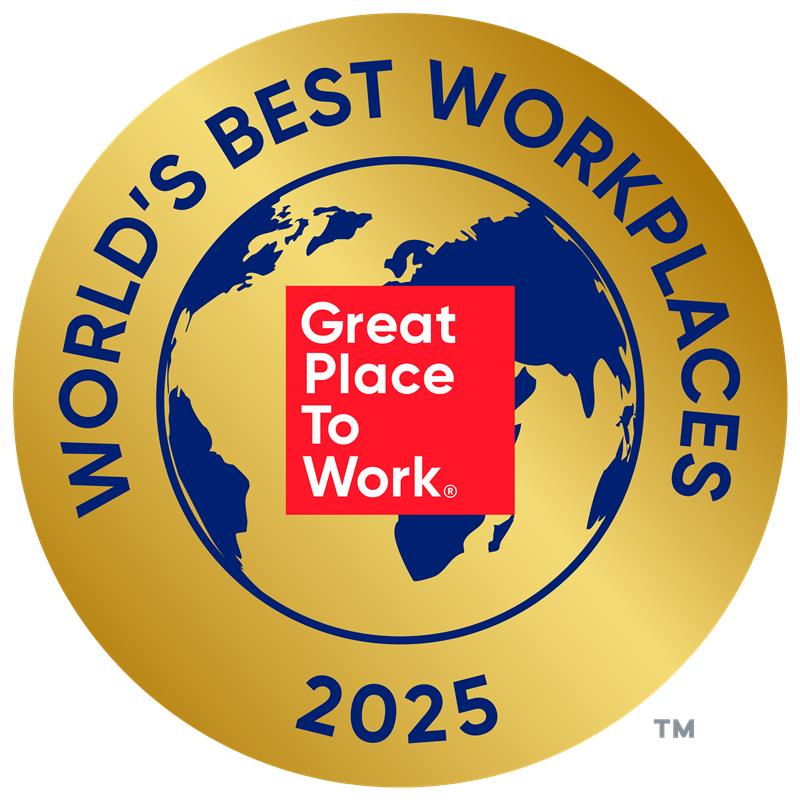
At Experian, we often say our people are our biggest superpower – and today, I’m thrilled to share that this belief has been recognised once again. Experian has been named one of the 2025 World’s Best Workplaces™ by Fortune and Great Place to Work® for the second year in a row.
This achievement reflects the culture we’ve built together – one that’s welcoming, inclusive, and rooted belonging. It’s a celebration of every colleague who brings their whole self to work, who lifts others up, and who powers opportunities for our clients, consumers, and communities.

We’ve made it our mission to create a workplace where everyone feels included, respected, and empowered. That’s why we’re proud to have earned top scores on the Corporate Equality Index and the Disability Equality Index, and to be recognised with the Outie Award for Workplace Excellence and Belonging.
These recognitions matter. But what matters most is how our people experience life at Experian. Whether it’s collaborating, innovating, or growing through world-class development of products, services and contributing to our communities, our culture is designed to help everyone thrive.
We’ve also made bold commitments to career development. Initiatives like Global Careers Week, the AI-driven performance coach Nadia, and the NextGen Forum – a global leadership development programme for emerging talent from across our regions – give our people the resources to take charge of their growth and build a “One Experian” mindset.
Being named one of the World’s Best Workplaces is a moment to celebrate but also a reminder to keep aiming higher. The world of work is evolving fast, and so are we. From embracing AI to enhancing our digital workplace experience, we’ll continue to push forward and listen to our people every step of the way.
Questions we will discuss:
- What does “retirement readiness” mean to you, and how can someone tell when they are financially ready to retire?
- Is there a magic number for retirement savings, and what factors should someone consider when setting a retirement goal?
- How can someone estimate their retirement expenses realistically?
- What are some common myths or misconceptions about how much money you need to retire?
- How should Gen Z, Millennials, and Gen Xers each approach retirement planning differently based on their stage of life?
- What are the biggest obstacles people face when trying to save for retirement, and how can they overcome them?
- How can you balance saving for retirement with paying off debt or supporting family today?
- What tools, calculators, or strategies can help people figure out if they’re on track for retirement?
- How can people prepare for unexpected costs or life changes that could impact their retirement plans?
- What’s one piece of advice you’d give someone just starting—or restarting—their retirement savings journey?
| Columns 1 | Column 2 | Column 3 | Column 4 |
|---|---|---|---|
| Row 1 Col 1 | |||
| Row 2 Col 1 | |||
| Row 3 Col 1 | |||
| Footer 1 | Footer 2 | Footer 3 | Footer 4 |

Credit Chat
Stretching your Dollars: Practical Tips to Cut Costs and Save More
February 5, 2025 3-4 PM ET
- What does “retirement readiness” mean to you, and how can someone tell when they are financially ready to retire?
- Is there a magic number for retirement savings, and what factors should someone consider when setting a retirement goal?
- How can someone estimate their retirement expenses realistically?

Greater transparency in buy now, pay later activity is key to helping consumers build their credit histories and supporting responsible lending. We have members of the military right now right out of high school and there’s not a lot of experience managing their own money. They’re quickly thrust into a place where they don’t have a support system to do that. We have members of the military right now right out of high school and there’s not a lot of experience managing their own money. They’re quickly thrust into a place where they don’t have a support system to do that. We have members of the military right now right out of high school and there’s not a lot of experience managing their own money. They’re quickly thrust into a place where they don’t have a support system to do that. We have members of the military right now right out of high school and there’s not a lot of experience managing their own money. They’re quickly thrust into a place where they don’t have a support system to do that. We have members of the military right now right out of high school and there’s not a lot of experience managing their own money. They’re quickly thrust into a place where they don’t have a support system to do that.
Experian North AmericaScott Brown, Group President, Financial Services

Did you know that there are 64 million people in the United States that have little or no traditional credit history? These people are typically referred to as underbanked or underserved consumers, and Experian just announced a new Extended View Score that can help these consumers gain access to credit products and services, which can lead them down the path of building a fuller credit history. Extended View is also beneficial for lenders as it can help them expand their lending universe. Steve Wagner, president of Experian Consumer Information Services, who also spoke today at CFSI’s 7th Annual Underbanked Financial Services Forum, said: Many of the estimated 64 million consumers with limited to no credit history that are unscoreable by traditional credit scores are creditworthy. Extended View can redefine how businesses evaluate this underserved population and empower more consumers with cost-effective credit and financial opportunities. See our news release for more information on Extended View Score. Photo: Shutterstock

Earlier this spring, the Federal Deposit Insurance Corporation (FDIC) announced a proposed amendment to the Assessments, Dividends, Assessment Base and Large Bank Pricing (LBP) rule that it put forward in February 2011. The revised rule attempts to address lender concerns that they would be unable to comply with the new rule’s provisions, particularly the added requirement of reporting subprime and leveraged consumer loans. Under the new proposal, subprime consumer loans would be renamed "higher-risk consumer loans and securities,” and would be defined as: All consumer loans where, as of origination, or, if the loan has been refinanced, as of refinance, the probability of default within two years was greater than 20 percent, excluding those consumer loans that meet the definition of a nontraditional mortgage loan; and Securitizations that are more than 50 percent collateralized by consumer loans meeting the criteria in (a), except those classified as trading book. The FDIC is reviewing comments on the changes and has extended the compliance date for the new reporting requirements until October 1, 2012.

Experian Healthcare, the leading provider of financial information services and market intelligence for health systems, hospitals, medical groups and specialty organizations, today announced that it is ranked No. 77 on the 2012 Healthcare Informatics (HCI) 100 list. Experian Healthcare includes the capabilities from the previous acquisitions of SearchAmerica® and Medical Present Value, Inc. (MPV). This year’s ranking for the organization is an improvement from MPVs ranking of 98 on the 2011 list. SearchAmerica was not previously listed. The HCI 100 is an annual listing of the top 100 health information technology (HIT) companies based on HIT revenue earnings from the most recent fiscal year. In collaboration with Porter Research and ST Advisors LLC, HCI reviews and analyzes company reported sales figures, official financial filings, press releases and information from unrelated healthcare industry consultants to determine the most deserving companies. “We are extremely proud to be included on this year’s HCI 100 list,” said Dan Johnson, president of Experian Healthcare. “Our jump in the ranking illustrates Experian’s commitment to this sector and underscores our dedication to delivering tools and services that help healthcare providers improve their financial health.” Check out the complete results of the HCI 100. For more information on Experian Healthcare’s products and services, visit www.experian.com/healthcare. Photo: Shutterstock
2024 Best Place to Work for Disability Inclusion


